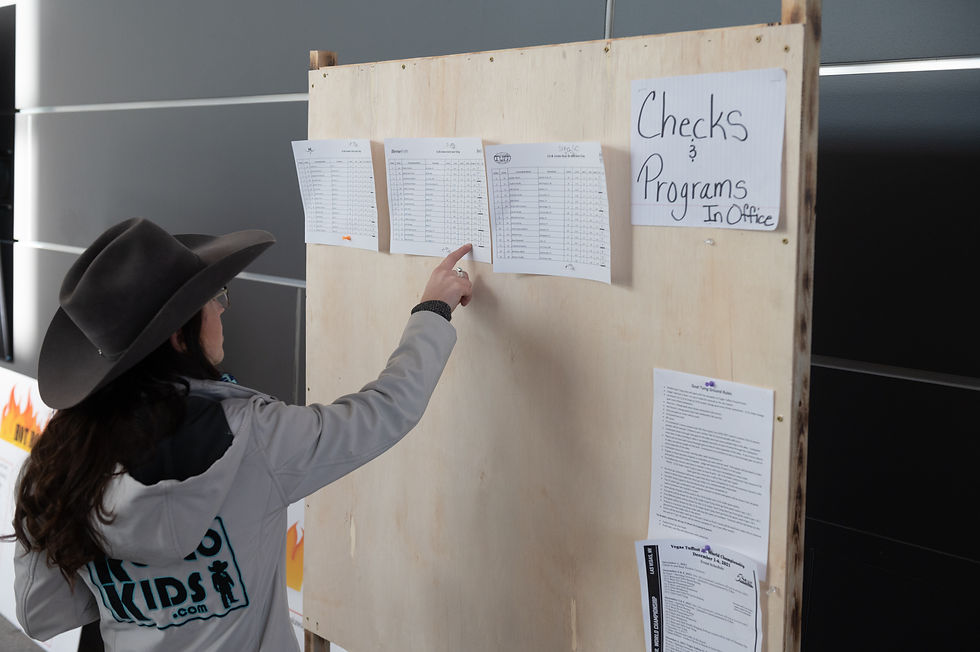General Event Rules
- Camarie Roorda
- Jan 16
- 5 min read
Anytime you go to a new association ask for a rule book. If the association doesn’t have their own rulebook, ask what rulebook they operate from. Many associations reference larger associations rule books like the PRCA or NHSRA rule book. Little changes from one association to the next can make or break your run. You are responsible for knowing the rules, even if you are new.
Professional Rodeo Cowboys Association (PRCA) Rule Book or the National High School Rodeo Association (NHSRA) Rule Book outline rules inside and outside of the arena from proper procedures, arena rules, time frames for entering, fines, animal welfare, individual event rules, etc.
Rules Pertaining to All Events
All rules are subject to change per event, association and organization.
It is your responsibility to know the rules that apply to the event you are at.
It is your responsibility to ask what set of rules/rule book the judges will be officiating from.
Rules that aren’t followed can result in penalties, fines and disqualifications.
If your hat falls off before you enter the arena, you may have a penalty or disqualification.
If you aren’t competing, but you want to be in the arena, you may have to wear official dress (a.k.a. western attire).
It is the competitor’s (not parent’s or announcers) responsibility to know the order in which they are to compete. Competing out of order can result in automatic disqualification.
Three-call: If the judge has the announcer call your name three times and you haven’t entered the arena, it results in automatic disqualification in any event.
If you are present, but cannot get your horse to enter the arena, it can still result in an automatic disqualification.
Time Limits: in the box or chute, if the stock you have drawn is cooperating but you aren’t nodding your head or your horse is acting up in the box excessively, the 60 second time limit can be enforced, resulting in an automatic disqualification.
It is the competitor’s responsibility to know the name/number of the stock they’ve drawn and the position they’ve drawn the stock in. The draw will be posted somewhere for everyone to see prior to each event. The draw will post the order in which you are to compete and the stock name or number you have drawn. The judge and livestock sorters will also have a list to cross-check. Before a competitor nods or enters the arena, it is his/her responsibility to check that the number/name of the stock loaded is the same listed on the draw. If you run in the wrong order, take the wrong steer or calf, or ride the wrong horse or bull, you will be disqualified. It is NOT the judge’s or the announcer’s responsibility to know your draw.
Contesting a Judge's Call
First, know you’re rule book.
Second, be kind.
If a judge makes a call you don’t agree with you can contest the call. After you’ve asked about the call, listen to their response. They will do their best to handle it.
If you still don’t agree with their call, walk away. Remember, you will see the same judges over and over again. One day the call might not land in your favor, but the next time it might. It all comes out in the wash.
Bareback Riding
Rider “mark out the horse” – see rule “Rodeo Terminology” for more information.
Qualified rides are 8 seconds
One hand must stay in the “riggin” the other “free hand” must stay in the air. If the free hand touches the animal at any time during the 8-seconds, the rider is disqualified.
Score is a combined total of how the horse and rider performed
Saddle Bronc Riding
Rider “mark out the horse” – see rule “Rodeo Terminology” for more information.
Must ride for 8 seconds to have a qualified ride
One hand must stay on the bronc rein
The “free hand” must stay in the air. If the free hand touches the animal, saddle or bronc rein at any time during the 8-seconds, the rider is disqualified.
Score is a combined total of how the horse and rider performed.
Tie-Down Roping
“Breaking the barrier” is a 10 second penalty
Time stars when the barrier flag moves
Time stops when three legs are tied up and the roper has both hands free and clear of the piggin string.
The run isn’t official until the roper has mounted his horse and the calf has stayed tied six seconds. If the calf becomes untied in the six seconds, it results in an automatic no-time.
If a calf is laying down when the roper gets to the calf, they must “day-light” the calf, meaning that they must have a chance to stand to the point that you can see day light between the calf and the ground.
Most associations have a jerk down and drag rules. Look up association rule books for more information.
Breakaway Roping
Time starts when the barrier breaks
Time stops when the rope nylon rope breaks off the saddle horn.
Different associations have different “legal” catches. All catches must drop over the calf’s nose and go around the neck.
Bell collar catch only: rope can only be around the calf’s neck. No legs, tails or anything else can be include.
As long as the rope clears the neck, some associations will call that legal. (i.e. the rope went around the neck and the calf stepped into the loop but it still broke off, would be a legal catch)
Goat Tying
Time starts when horse crosses an electric eye timer
Time stops when tyers hands are free and clear of the string
Goat must stay tied for six second after the tyer has stood up and stepped back a minimum of three feet. If the goat gets up within the six seconds, it results in an automatic no time.
If the goat is laying down when the tyer gets to the goat, they must “day-light” the goat, meaning the judge must be able to see day light between the goat and the ground before it can be tied.
Girls use a goat tying string. Boys use a goat tying piggin’ string that resembles a piggin’ string they use in the tie-down roping.
Barrel Racing
Time starts when horse crosses an electric eye line
Time stops when the horse crosses back across the electric eye line
Must complete the clover leaf pattern according to the rule book for the time to start.
If at any time the horse is to cross the electric eye line before the run is completed, it results in an automatic no time.
Any knocked barrel result in a 5 second penalty at rodeos and a no time at events in a D format.
Pole Bending
Time starts when horse crosses an electric eye line
Time stops when the horse crosses back across the electric eye line
Must complete the pole pattern according to the rule book for the time to start.
If at any time the horse is to cross the electric eye line before the run is completed, it results in an automatic no time.
Any knocked poles result in a 5 second penalty at rodeos and a no time at events in a D format.
Bull Riding























Comments